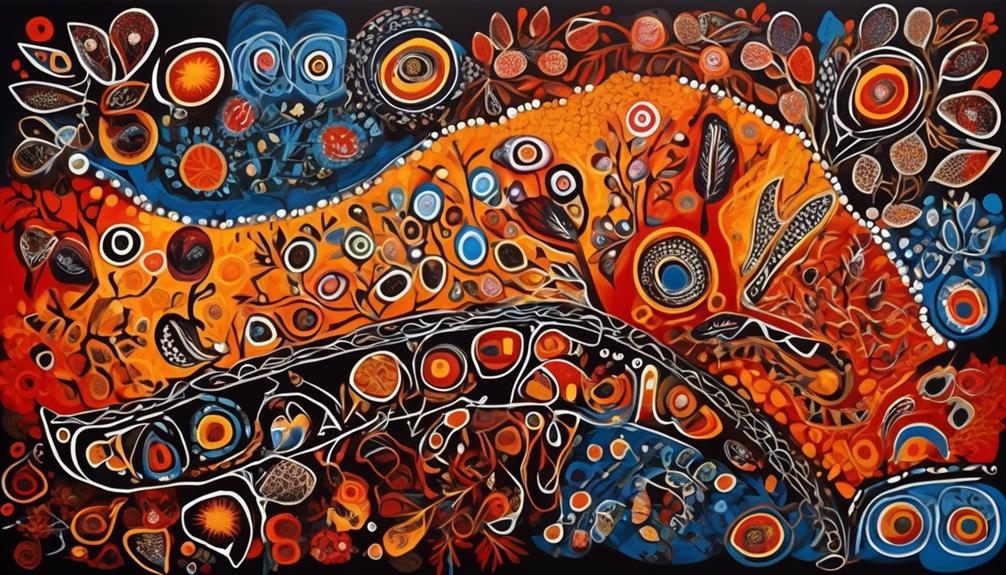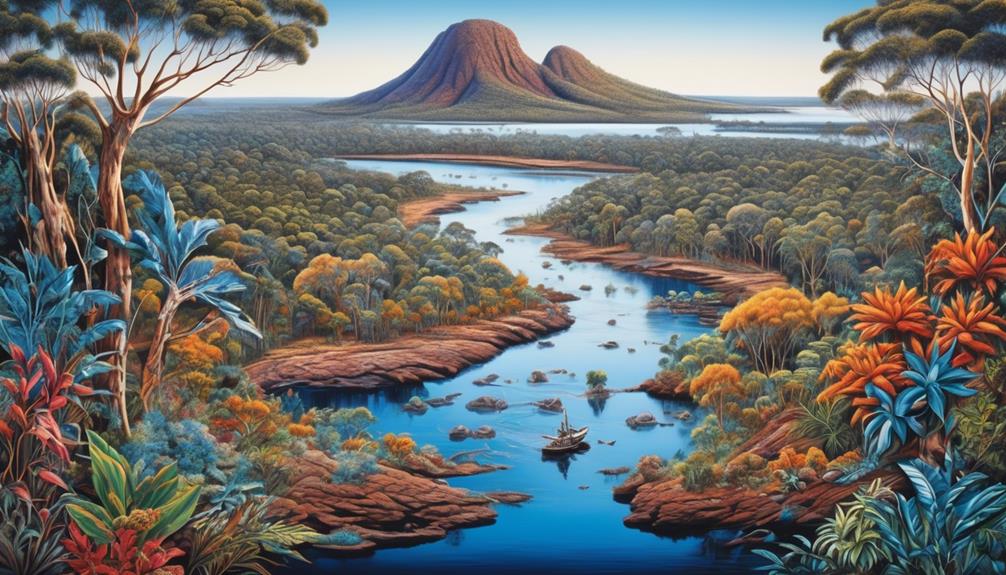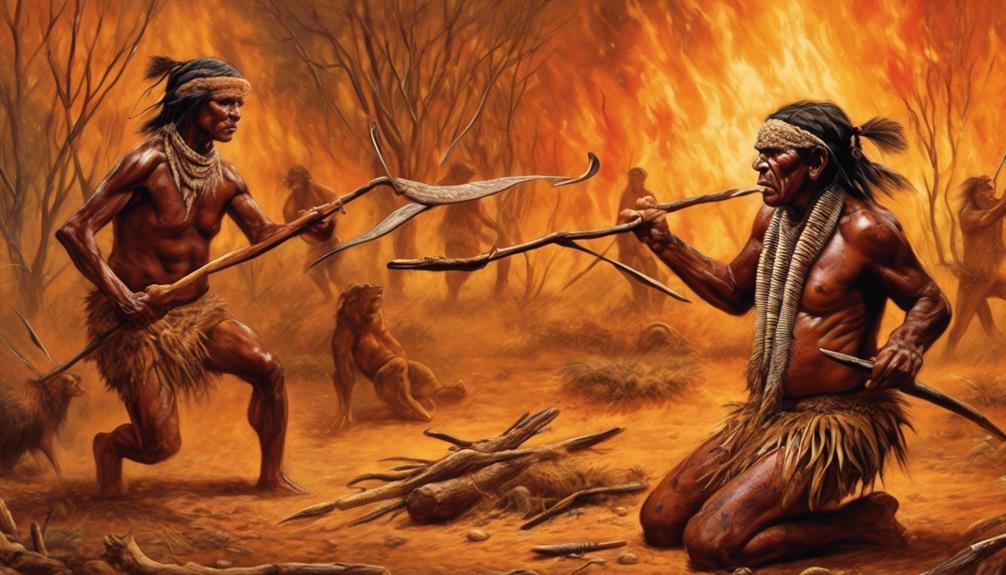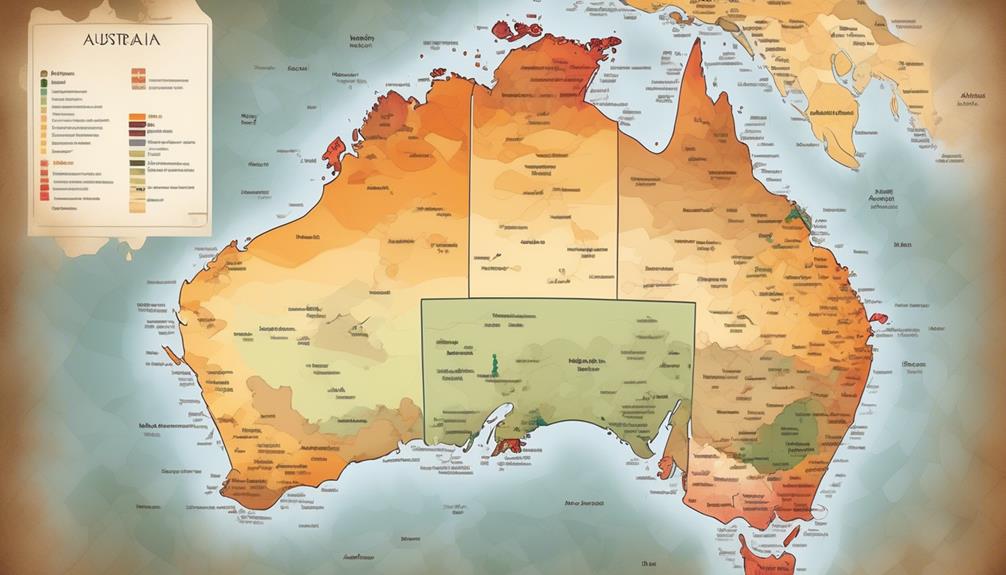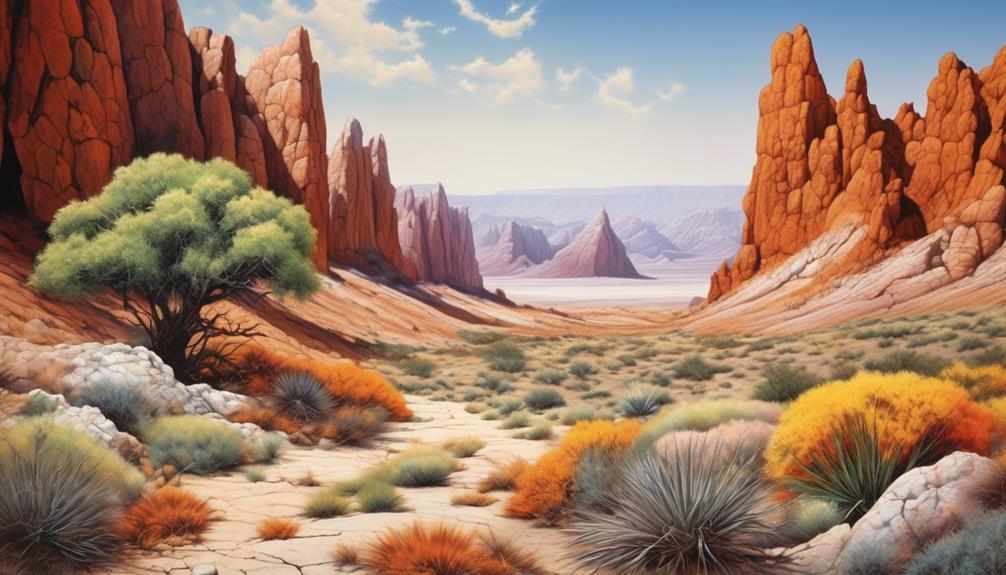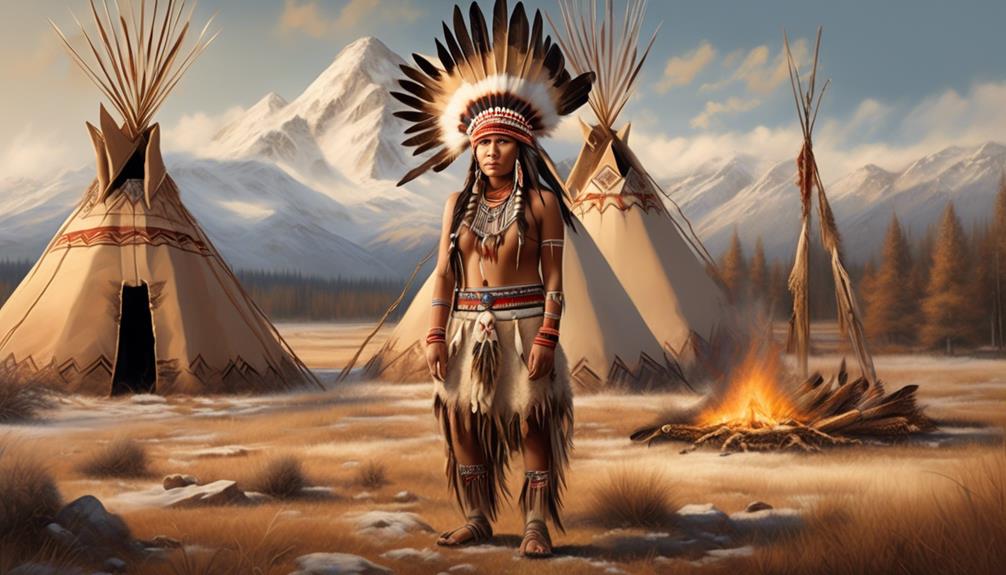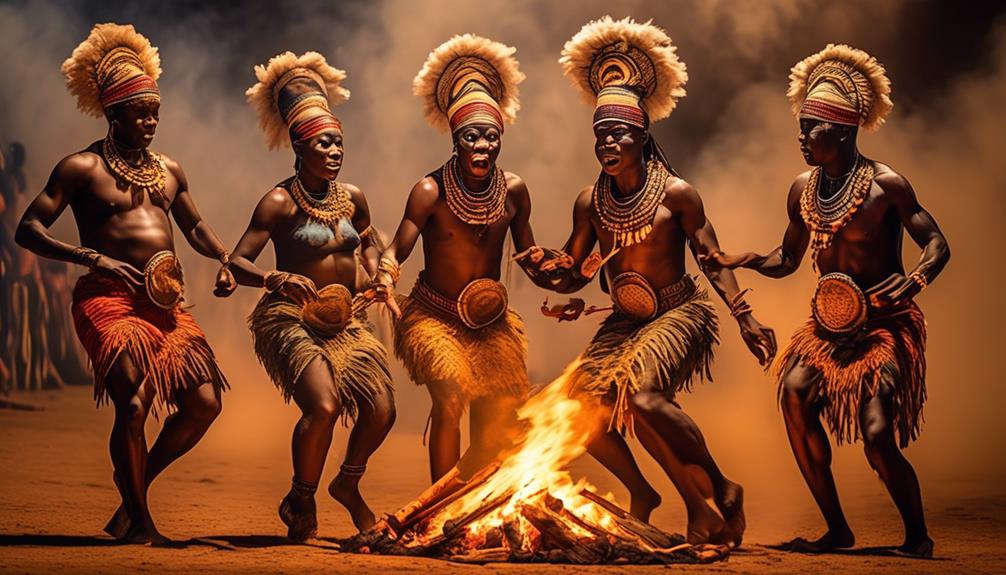Noongar artwork is like a tapestry woven from the threads of history, culture, and identity, creating a intricate and stunning design that speaks volumes without saying a single word.
As you explore the world of Noongar art, you'll uncover a fascinating journey through time, from ancient traditions to modern interpretations.
The vibrant colors, intricate patterns, and powerful symbols all hold stories waiting to be unraveled, offering a unique perspective on the Noongar people and their enduring artistic legacy.
Key Takeaways
- Noongar art is deeply rooted in the cultural identity and storytelling of the Noongar people.
- Noongar art serves as a visual language, conveying stories of creation, spiritual beliefs, and interconnectedness.
- Noongar art incorporates symbols representing seasonal changes and reflects the importance of family and community.
- Traditional techniques and natural materials are fundamental to Noongar art, preserving and passing on Noongar cultural heritage.
History of Noongar Art
Exploring the history of Noongar art reveals a rich and diverse tradition rooted in the cultural identity and storytelling of the Noongar people. Noongar art is deeply intertwined with the spiritual and cultural practices of the Noongar community, reflecting their connection to the land and their ancestral stories.
Traditional techniques such as rock and sand painting, carving, and weaving have been passed down through generations, preserving the authenticity and essence of Noongar art. These techniques aren't merely artistic expressions but hold profound cultural significance, serving as a means of passing down knowledge, traditions, and spiritual beliefs.
The cultural significance of Noongar art lies in its role as a visual language, conveying stories of creation, spiritual beliefs, and the interconnectedness of all living things. Each symbol, motif, and color carries layers of meaning, reflecting the Noongar people's deep understanding of their environment and their place within it.
Through the intricate patterns and designs, Noongar art serves as a powerful medium for preserving and sharing the wisdom and heritage of the Noongar people with the world.
Symbolism in Noongar Art
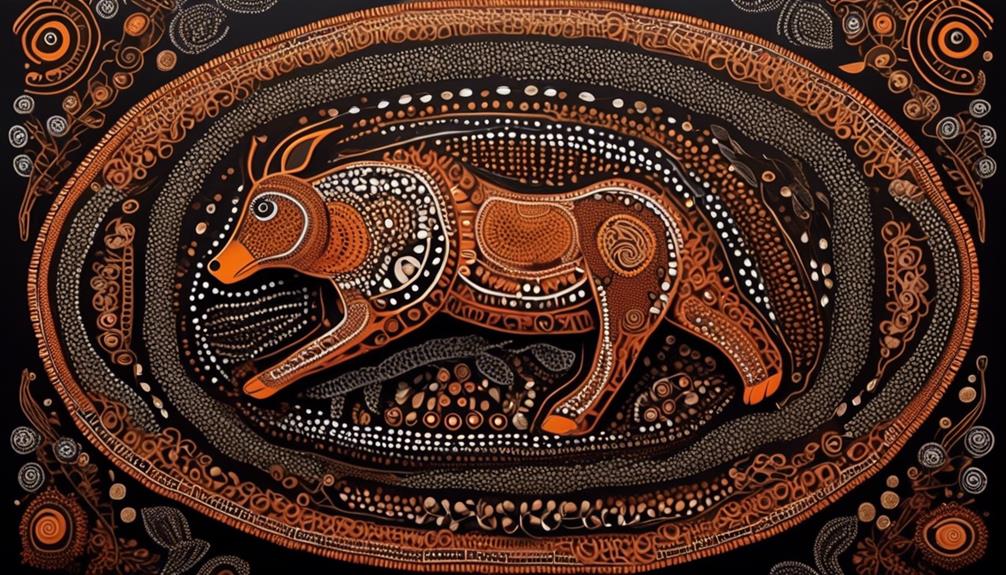
Symbolism in Noongar art encompasses a rich tapestry of visual storytelling, weaving together ancestral wisdom, spiritual beliefs, and the interconnectedness of life within the intricate patterns and designs. Noongar art holds deep cultural significance, with each motif and symbol carrying generations of knowledge and traditional values.
Here are some key aspects of symbolism in Noongar art:
- Connection to Country: Noongar art often depicts the deep connection to the land, emphasizing the spiritual and cultural significance of specific sites and landscapes.
- Dreamtime Stories: Traditional motifs in Noongar art frequently represent Dreamtime stories, illustrating the creation of the world, ancestral beings, and the natural environment.
- Family and Community: Many symbols in Noongar art reflect the importance of family and community, showcasing the values of unity, support, and kinship.
- Seasonal Changes: Noongar art often incorporates symbols representing seasonal changes, reflecting the deep understanding of nature's rhythms and the significance of each season.
- Spiritual Beliefs: Symbolism in Noongar art also conveys spiritual beliefs, depicting totems, rituals, and ceremonies that form an integral part of Noongar culture.
Understanding the symbolism in Noongar art provides a glimpse into the rich tapestry of Noongar culture, offering profound insights into their heritage and traditions.
Techniques and Materials Used
In understanding the deep cultural significance of Noongar art and its rich symbolism, it becomes evident that the techniques and materials used play a pivotal role in bringing these ancestral stories and values to life.
Noongar art is deeply rooted in traditional techniques that have been passed down through generations. One of the most commonly used techniques is dot painting, where natural ochre pigments are meticulously dotted onto various surfaces to create intricate patterns and designs. This technique not only requires great skill and precision but also holds deep spiritual and cultural meaning.
Natural materials such as ochre, clay, and plant extracts are fundamental to Noongar art. Ochre, derived from the earth, holds significant cultural importance and is used not only for its vibrant color but also for its connection to the land and the ancestors. The use of natural materials is a testament to the Noongar people's deep respect for the environment and their traditions.
The intricate and meticulous use of traditional techniques and natural materials in Noongar art serves as a powerful means of preserving and passing on their rich cultural heritage.
Contemporary Noongar Artists
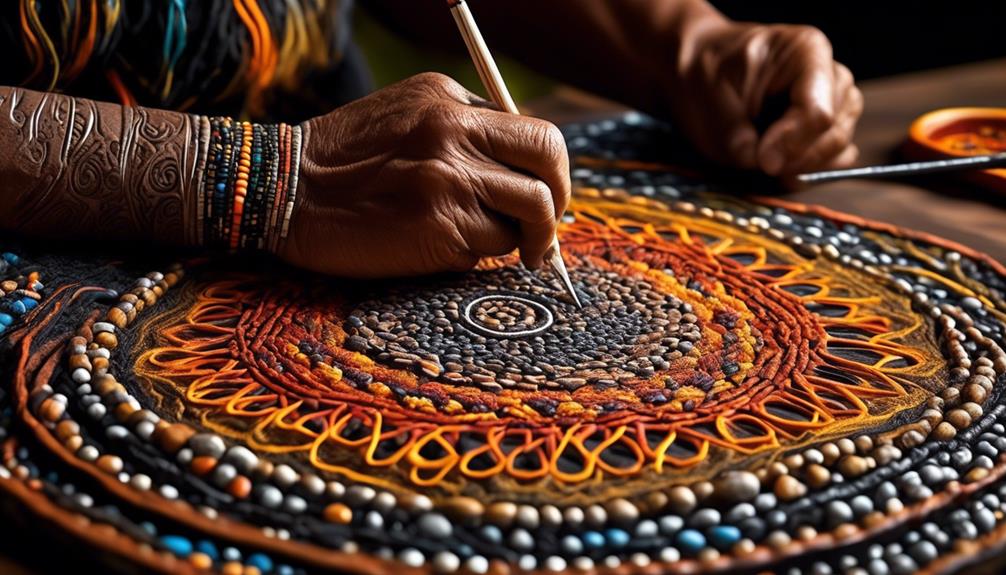
Contemporary Noongar artists continue to draw on traditional techniques and materials, infusing them with innovative and personal expressions that reflect the evolving nature of Noongar art. These artists are contributing to the rich tapestry of Noongar cultural expression through their work.
Here are some key aspects to consider about contemporary Noongar artists:
- Interpretation of Tradition: Contemporary Noongar artists skillfully reinterpret traditional Noongar art forms, such as dot painting and storytelling, to convey modern themes and experiences.
- Exploration of Identity: Many contemporary Noongar artists explore themes of identity, connection to country, and the impact of historical and ongoing experiences on their communities through their art.
- Experimentation with Mediums: These artists aren't bound by tradition and often experiment with a wide range of mediums, from acrylics and oils to digital art, to convey their cultural narratives.
- Community Engagement: Contemporary Noongar artists actively engage with their communities, using their art as a means of cultural preservation, education, and empowerment.
- Global Influence: Noongar artists are gaining recognition on the global stage, contributing to the wider conversation around Indigenous art and cultural representation.
The work of contemporary Noongar artists is a testament to the ongoing vitality and relevance of Noongar cultural expression in the modern world.
Preservation and Revival Efforts
Efforts to preserve and revive Noongar cultural practices and art forms have become increasingly important in ensuring the continuation of this rich heritage for future generations. The preservation efforts aim to safeguard traditional knowledge, language, and artistic expressions, while the cultural revival seeks to reignite pride and connection to Noongar identity. Through initiatives such as community-led language revitalization programs and the establishment of cultural centers, the Noongar people are actively reclaiming and celebrating their heritage.
| Preservation Efforts | Cultural Revival | Connection to Heritage |
|---|---|---|
| Language revitalization | Traditional art workshops | Cultural education programs |
| Recording oral histories | Cultural festivals | Community storytelling |
| Archiving traditional knowledge | Indigenous art exhibitions | Land conservation efforts |
These preservation and revival efforts serve as a testament to the resilience and determination of the Noongar people in safeguarding their cultural legacy. By actively engaging in these initiatives, the Noongar community is not only preserving their heritage but also ensuring that it thrives and continues to enrich the lives of future generations.
Frequently Asked Questions
How Has the Noongar Art Scene Evolved Over Time in Response to Modern Influences and Global Trends?
Over time, art styles have evolved in response to global influences and contemporary inspiration.
This evolution is evident in the Noongar art scene, which has adapted its traditional cultural practices to incorporate modern trends. The art has embraced new techniques and materials while staying rooted in its cultural heritage.
Noongar artists have skillfully blended traditional and contemporary elements, creating a dynamic and evolving art scene that reflects the global influences and modern trends of today.
What Role Do Traditional Stories and Cultural Practices Play in Inspiring Contemporary Noongar Artists?
Traditional stories and cultural practices are pivotal in inspiring contemporary Noongar artists. They provide a deep well of inspiration, connecting past and present, shaping artistic expressions.
Are There Any Specific Protocols or Cultural Considerations That Non-Noongar Artists Should Be Aware of When Incorporating Noongar Themes in Their Work?
When incorporating Noongar themes in your work, it's crucial to prioritize cultural sensitivity, respectful collaboration, and ethical representation. Understand the significance of Noongar cultural protocols and be mindful of any specific cultural considerations. Remember that your artistic expression should be guided by a deep respect for the Noongar culture.
How Are Noongar Artists Adapting to the Challenges of Climate Change and Environmental Degradation in Their Art Practices?
Adapting to climate change and environmental degradation, Noongar artists employ diverse adaptation strategies in their art practices. Through their work, they convey a deep environmental consciousness and resilience, reflecting the interconnectedness of culture and the natural world.
What Initiatives Are in Place to Ensure That Noongar Art Continues to Thrive and Remain Relevant for Future Generations?
To ensure the thriving and relevance of Noongar art for future generations, numerous initiatives are in place. These efforts focus on cultural preservation, art evolution, and incorporating global influences.
Conclusion
So, next time you visit Western Australia, keep an eye out for the vibrant and meaningful Noongar art.
You might just stumble upon a piece that speaks to you in ways you never expected.
Embrace the rich history and contemporary revival of Noongar art, and take a piece of this ancient culture home with you.
You never know how it might inspire and enrich your own life.
Mary is a passionate writer who brings creativity and a fresh perspective to our team. Her words have the power to captivate and inspire, making her an essential contributor to our content. Mary’s commitment to storytelling and dedication to promoting Indigenous culture ensures that her work touches the hearts of our readers. We’re fortunate to have her as part of our team.
